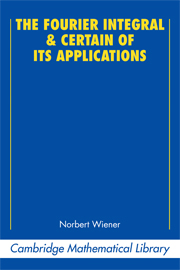Summary
This is a most inspired and inspiring book.
When it was written two of Wiener's major papers had just appeared: Generalized Harmonic Analysis, and Tauberian Theorems. His previous works on potential theory, Brownian motion, Fourier analysis were highly appreciated by a few dozens of mathematicians in the world. It was a happy time in the life of Norbert Wiener. He was thirty-seven years old, he had been married for six years, he had just been promoted to a professorship at the Massachusetts Institute of Technology, and he had spent a pleasant year in Cambridge, England, with his wife Margaret and their small daughters, Barbara and Peggy.
Cambridge (I mean, Cambridge, England) plays a special role in Wiener's life. The beginning of his mathematical career coincided with his meeting with Bertrand Russell in Cambridge in 1913. He had just graduated from Harvard in mathematical logic – at only eighteen – and was supposed to go on in logic with Russell. Actually Russell's advice was to learn more mathematics and physics. Accordingly, Norbert Wiener took courses with Hardy, Littlewood, Mercer, and read Einstein's papers of 1905, and Niels Bohr's recent works. Without any doubt Einstein's theory of Brownian motion had a decisive role in Wiener's inspiration.
The academic year 1931–32 in Cambridge was an opportunity for Wiener to meet Hardy and Littlewood again, to lecture on Fourier integrals (in Hardy's chair) and to discover an ideal collaborator, the young R. E. A. C. Paley.
- Type
- Chapter
- Information
- The Fourier Integral and Certain of its Applications , pp. ix - xivPublisher: Cambridge University PressPrint publication year: 1988

